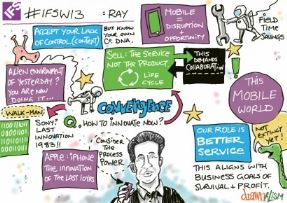This is one of a series of live blog posts directly from the site of the 2013 IFS World Conference in Barcelona. Business journalist Adam Tinworth is a veteran of Reed Business Information and a lecturer on digital journalism at City University in London. His first-hand impressions are accompanied by illustrations of Matthew Buck, cartoonist for Drawnalism.
 Where will you business be in 2015? No-one in the room was willing to commit to knowing that. Very few had any sort of IT plan. How many companies have been created and destroyed in the last 2 years? 52% of the Fortune 500 have been destroyed, acquired, shut down, merged or similar over the last decade.
Where will you business be in 2015? No-one in the room was willing to commit to knowing that. Very few had any sort of IT plan. How many companies have been created and destroyed in the last 2 years? 52% of the Fortune 500 have been destroyed, acquired, shut down, merged or similar over the last decade.
There’s change. There’s macro trends we can’t control – like storms and political incompetence. But the way, place, manner and drivers of work are changing. The number of people in the room who work from home has quadrupled in the past five years. 15 to 17 year olds communicate by looking at phones.
We have a tonne of disruptive technology adoption – and business models are changing rapidly. In 2008 General Motors was worth $48bn. Based on todays’ figures, Google could now buy GM and shut it down if it wanted, just for a bit of weekend fun.
It’s mobile, it’s social, it’s cloud. People are in networks, devices are in networks. But it’s none of these things alone. It’s the convergence of mobile, social, cloud, video and big data that’s changing things. The average individual is no more then 1m from a device in the working day – and all of them have more computing power than took us to the moon.
We have to think about how we innovate. Will you disrupt – or be disrupted? You don’t want to be one of those 52%.
Understand Innovation
The Sony Walkman arrived in 1983. That was the last piece of innovation from Sony – 30 years ago. There were other people who did everything else they’re done since first. Ray cut lawns to pay for university – and had to wait three years for the incremental innovation – the double cassette player!
Apple’s innovation wasn’t the iPod – it was the fact they persuaded you to pay $1 for a song at the height of music piracy. The iPhone destroyed 27 different business models. This is once in a generation transformation. Sony could have done this. But Apple became Sony as Sony tried to become Apple. Could Samsung disrupt Apple?
We are not selling products and services any more. People sell experiences or outcomes – you’re selling an SLA, the promise to fulfil something. What is the business model in the airline industry? Revenue per passenger kilometre. the A380 is about putting more butts on seats. It doesn’t change things. The Dreamliner change things – it creates new routes.
Look at Siemens. Their machines cost €1 to €2m. But they don’t sell them anymore – they’re selling a number of scans. Disney doesn’t sell theme parks. f you’re old enough, if you’ve bought the same movie five times on different mediums. When you have kids – you do it again, and go on holidays with them. You buy into a Disney experience – and trust it.
Mobile as the access point to experience
Mobile is become an access point to all this. Do I need an ID? Maybe my mobile will do that. Collaboration and connection relies on mobile. Augmented reality will allow you to add layers of information to what you’re seeing – you could know what you need to know before you walk in the building. Plant maintenance is ripe for disruptions. Tesla robots are talking to each other all the time. Mobile can change field service completely.
On the consumer level, you can optimise supply chains based on intent information, payment systems make purchase easier. B2B and B2C are coverging. In fact, they’re dead. We’re in a people to people and machine to machine age.
This all leads to a stark division between winners and losers. The gap between the top three brands in the market and the rest is getting bigger.
Seven things you need to understand
- Understand business models are shifting.
- It’s not just about mobility, it’s about changing the journey.
- Business value must happen at the business process level
- It’s about context – it’s all contextual so it can be relevant. Location, time, sentiment…
- Digital business disruption is a mindset
- Mobile ROI must be part of a larger initiative
- You need a network of smaller and larger supply chains
Mobile adoption is a progressive model. You explore, you experiment, and then you start telling people about it. You spread it through the business and your customers. And finally, you decide what you’re not going to do.
Are you incremental or transformational? Are you reactive or proactive? The transformational and proactive are the market leaders – and they’re 5%. The fast followers are typically number 2 – about 15% of business. Cautious adopters are proactive and incremental. They take their time – they’re 50% of the market. Laggards require external stimulus to change. Understand where you are on that.
There’s a huge difference between what IT wants and what the business wants IT wants safe, secure and sustainable. The business wants simple and sexyt. This needs to be bridged. Unless IT and the rest of the business can be friends, you can’t match this pace of change.
Start with mobile. It’s the beginning of the process.